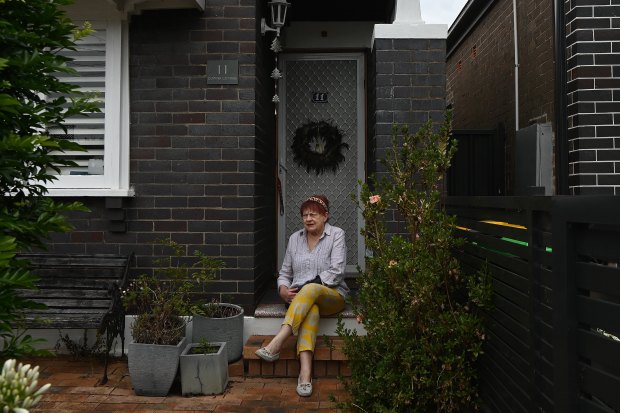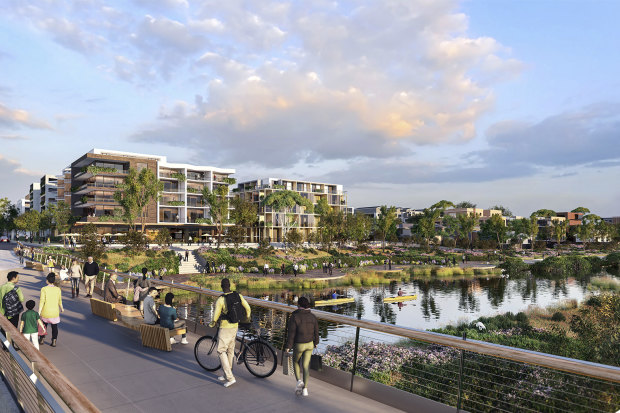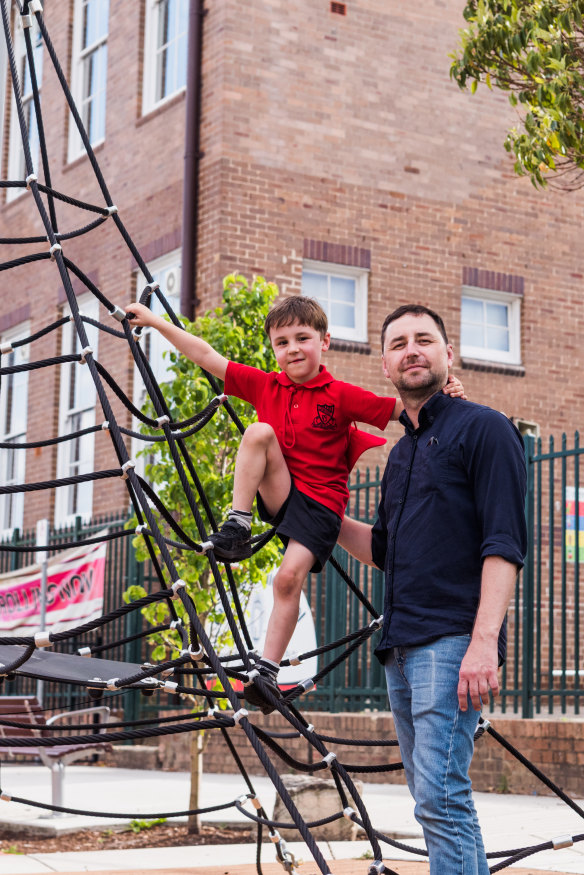This was published 1 year ago
‘Deadset against it’: After 80 years in the same home, bulldozers are coming
Development will be a major issue in the March state election. Sydney needs more housing but communities across the city, like Campsie, are baulking at the rapid changes to their suburbs.
By Jordan Baker
Kenneth Campbell, 85, has lived in his Campsie home since he was two years old. He remembers when the streets were gravel, cows grazed in nearby yards and the Cooks was a real river, not a concrete canal. Neighbour Caroline Gillham-Racz, 75, has lived in the same street for six decades, while Garry Toogood was born on a Campsie kitchen table 80 years ago and has lived in the south-west Sydney suburb ever since.
All three found out through word of mouth about Canterbury-Bankstown Council’s plans to rezone most of the suburb as high-rise residential as part of a major development push along the Sydenham-to-Bankstown corridor. It will allow towers of up to 18 storeys in their streets. They feel powerless, betrayed and worried that their homes will be surrounded by a concrete jungle. “I’m deadset against it,” Toogood says. “I don’t mind progress, but in the right way.”

Caroline Gillham-Racz, 75, in front of her home in Campsie, where she has lived for 50 years. “They can take me out in a box,” she says.Credit: Kate Geraghty
They are not alone. The council’s master plan has divided everyone from locals who feel they’ve been left without a voice, to developers who are frustrated about the way the process has been handled and say investing in the area is not viable. “I’m all for revitalisation,” says another resident, Colin Cosier. “But is it truly being done in the interests of the community, with the community, and for the community? I think not.”
Development will be a major issue in the March state election. Sydney needs more housing – on Monday, Premier Dominic Perrottet announced 10 more land rezonings, allowing 70,000 more homes mostly in western Sydney – but communities across the city are baulking at the rapid changes to their suburbs, particularly when amenities such as schools, parks and roads fail to keep pace. The Labor opposition and some independents have identified the issue as an electoral vulnerability for the Coalition. But in some parts of Sydney, such as the south-west, it’s Labor councils coming under fire for overdevelopment.
Campsie’s story is one that’s echoed across Sydney.
It sits on the Sydenham-to-Bankstown corridor, an area that’s been slated for some of the city’s most intensive development due to the NSW Coalition government’s controversial decision to rip up the old train line and replace it with the Southwest Metro. One rationale for choosing the Bankstown line was that land along it – represented mostly by Labor at local, state and federal levels – had been underdeveloped; there are still single-storey houses on 400-square-metre blocks just 30 minutes from Sydney.
The main street is tired. There’s an opportunity for urban renewal. But locals have little faith in the process because they have seen how badly it can go wrong. The increasingly traffic-clogged Canterbury Road, which cuts Campsie in two, is lined by haphazard apartment blocks that stand as an enduring and ugly monument to the favouritism shown to certain developers by the former Canterbury Council, which was investigated by the Independent Commission Against Corruption (the council has since been amalgamated with Bankstown).

Art deco facades in Campsie, which is about to be rezoned for high-rise residential.Credit: Jessica Hromas
They’ve also watched the saga of Vicinity Apartments, an already-decrepit apartment block near Campsie on the Cooks River which an engineer warned was in serious risk of collapse just six years after it was finished. The same developer, Toplace, has purchased a key site in the masterplan, the Campsie Centre, for $100 million.
Sydney has been developing its suburbs for decades, but “I’m not sure we’ve done a lot of it very well,” says experienced planner Patrick Fensham, who has called for ‘Urban Renewal Community Compacts’, which would involve making guarantees about livability to communities. “Often it’s been fairly poor quality in terms of amenity and access to open space, and access to community services and social infrastructure.”
The NSW government announced its ambitious plan to build 36,000 new dwellings along the south-west corridor in 2015. It gave responsibility for rezoning the corridor to the Department of Planning, which spent years and many millions of dollars holding community consultations. Developers jostled for land. Millions stood to be made at the stroke of a pen.
Canterbury-Bankstown Council was vocal in its opposition. Mayor Khal Asfour warned of a “concrete jungle” and said the department was too focused on housing without considering the infrastructure to support it. “I want [the Department of Planning] to tell me how 25-storey towers are supposed to make those centres better places?” he said.
Yet in a sudden and surprising move in 2018, the government offloaded rezoning responsibility to councils, which had to start again from scratch. Multiple Coalition sources, speaking on the condition of anonymity so they could speak freely, told the Herald that the government did not see the point in a protracted political fight with Labor MPs and councils. If they were so invested, they could do it themselves.
The decision came about a week after former premier Gladys Berejiklian announced Wagga Wagga MP Daryl Maguire – who, it later emerged, she had been secretly dating – would quit politics because an ICAC inquiry into the former Canterbury council heard him bragging about his attempts to broker property deals.
A spokesman for the Department of Planning says planning controls were handed back at the request of council and the community. “We are focused on supporting new and affordable housing to ensure everyone has a roof over their head, in the right locations, and we work closely with communities and councils to ensure we get the planning right,” the spokesman said.
Councils left with ‘hospital handpass’
Now it’s the Labor council – which will face a parliamentary inquiry into its activities next month – in the hot seat, itself accused of prioritising housing over infrastructure. Local councils are not responsible for state-level services such as schools, hospitals and public transport, but that’s cold comfort to residents. “I was disappointed that the state walked away,” Fensham says. “What they should have said is, ‘we will rethink this as a partnership’. Poor old councils have ended up with the hospital handpass.”
Under the council’s plan, which is awaiting final tick-off from the planning minister, Campsie Public School, which is already among the public primary schools with the least play space and has no grass, will be surrounded on three sides by towers. It will also need to accommodate more kids, who will move into the extra 6000-odd new apartments with their parents.

Towers of up to 25 storeys will be built under the Campsie masterplan. Locals say the brochure (pictured) does not reflect the realityCredit: City of Canterbury Bankstown
Cosier is a dad at the school. “As a Campsie resident, I got the glossy brochure [about the plan from council],” he says. “If you look at the image they used [on the front], it was a low-storey building with lots of green space. If you read through it, it sounds wonderful. Jobs. Livability. Nowhere do they mention that the school is going to be surrounded by 30-metre buildings. I would have thought ... that the council or state government would come and talk to us and discuss what it means.”
Few residents understand the plans, or how they will change the suburb. Many speak English as a second language, and some don’t speak it at all. “Planning stuff is confusing. It’s not really accessible for most people,” he says. “You need extra effort for communication; ‘hey this is what the council and government are thinking’. It’s not even been absent; I feel like it’s been avoided. What’s been communicated isn’t the reality.”

Colin Cosier, pictured with his son, is concerned about the proposed development shadowing Campsie Public School. “I’m all for revitalisation. But is it truly being done in the interests of the community, with the community, and for the community? I think not.”Credit: James Brickwood
The parents at Harcourt Public School are also upset. Under one option considered in a traffic management report, the school would lose a chunk of its grass to a bypass road.
The council points out that its masterplan has won a Planning Institute award, and says it gives clarity to state agencies to plan infrastructure. A council spokesperson said, “we did everything we could to ensure our multicultural community was well-informed and had their chance to provide feedback,” including a drop-in office, translated material and a multilingual call-back line.
The Campbells learned about the rezoning from neighbours. They don’t want to sell – Kenneth moved into his house when he was two years old, and his wife Maxine joined him 60-odd years ago – but they already feel the pressure. Real estate agents have been knocking on their door. They need to fix their roof, but don’t know if it’s worth spending thousands of dollars if their house will be knocked down. Their neighbours a few doors down just poured hundreds of thousands of dollars into a renovation.
“In this shiny book,” said Kenneth, pointing to a copy of the master plan, “there’s not one word in there about the residents that have been here in their homes long-term. It’s all the shiny sparkling things for the people who are going to come in.”
Toogood learned about the master plan a few weeks ago from independent local councillor Barbara Coorey, and is angry. “We do not have a say in anything,” he said. “They just do what they want to do. I’m not going to sell. I’m too old. I love Campsie.” Gillham-Racz won’t sell either, although she does not like the idea of being surrounded by high-rises. She has no children and her husband died many years ago, so her neighbours are like family. “They can take me out in a box,” she said.

Gynandra Naicker said he did not receive the letter inviting him to make submissions on the rezoning until submissions had closed.Credit: Jessica Hromas
Several Labor elders, including former federal parliament speaker Leo McLeay, supported a rally last month that was organised by Coorey, who says the plan will destroy the suburb’s character and heritage. “This development is akin to Wolli Creek or Green Square on steroids,” she says. “This is a complete rebuild of a suburb. Street after Street will be soulless apartment towers soaring into the sky, destroying community and history.”
Developers are not happy either. The process has dragged on since 2015 and there has been so much property speculation that prices have climbed to the point that some now think the floor space ratio designated by the council is not generous enough to make their projects worthwhile. The high number of lifelong residents of Campsie – it is one of the most tightly-held suburbs in Sydney – also push land prices up. “I was very lucky to get out,” says one developer, on the condition of anonymity, who sold options he had bought a few years ago.
“There’s not one word ... about the residents that have been here in their homes long-term. It’s all the shiny sparkling things for the people who are going to come in.”
Kenneth Campbell
Opponents to development are often dismissed as NIMBY (Not In My Back Yard) boomers standing in the way of housing affordability for millennials. But Fensham said that was unfair.
“We need to do better in persuading communities or at least bringing them along with the arguments, and the dividends that can come from [development],” he says.
“Good open space. Good community services, good childcare, good primary schools. There’s nothing more likely to build community resistance than development that changes the character and nature of the area that doesn’t seem to be accompanied by those things.”
The Morning Edition newsletter is our guide to the day’s most important and interesting stories, analysis and insights. Sign up here.